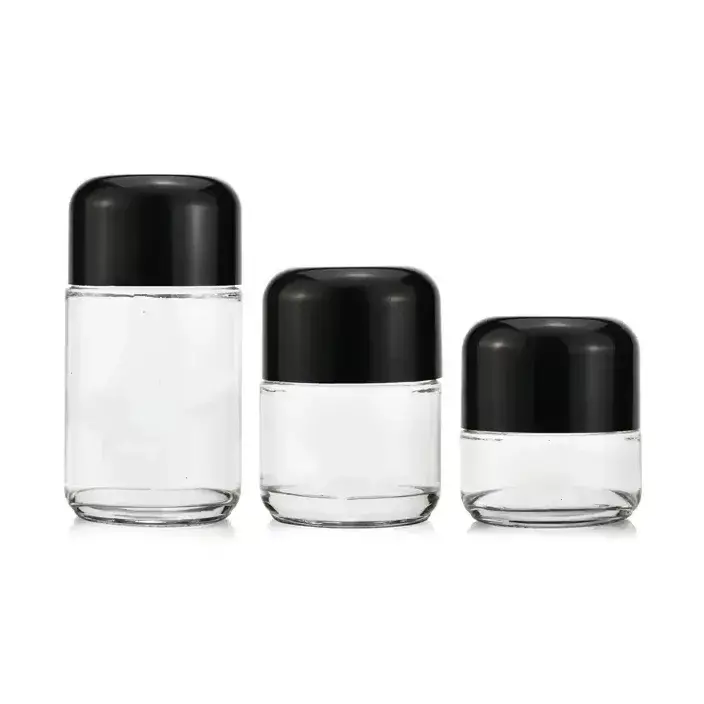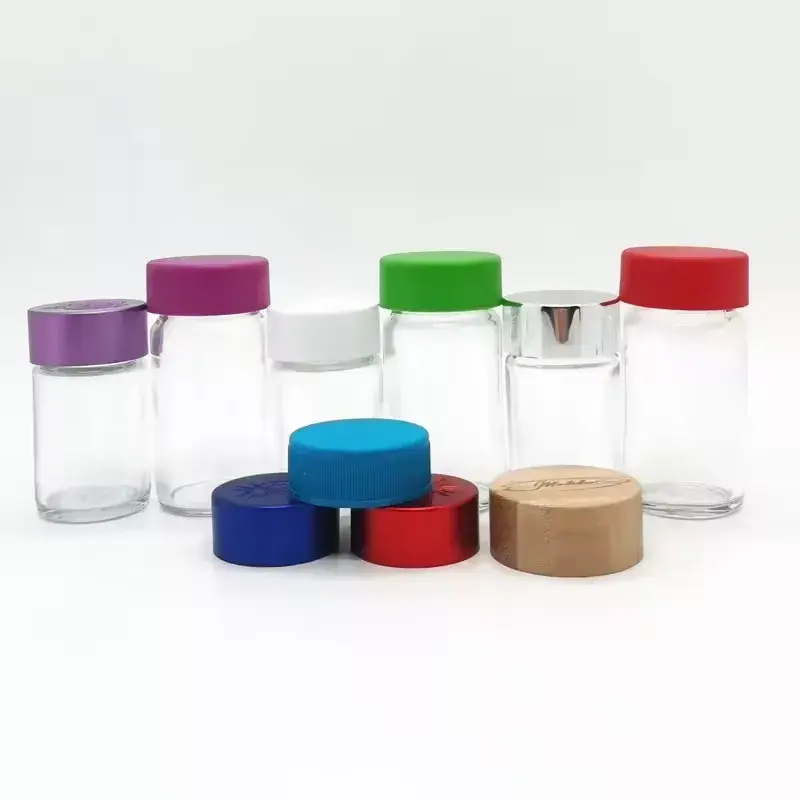Preserving the quality, potency, and flavor of your cannabis concentrates like shatter and dab is paramount for any business in this growing industry. The container you choose plays a massive role in this. This article dives deep into the world of concentrate containers, with a special focus on glass concentrate container options. As Allen, a factory owner with 7 production lines in China specializing in high-quality gas cylinders, I understand the critical importance of material quality and reliable packaging solutions, whether for N2O or for sensitive cannabis products. We'll explore why the right concentrate container matters, compare materials, and discuss best practices for storing your concentrate. This guide is essential for anyone looking to optimize their product presentation and preservation, helping businesses like yours satisfy discerning customers such as Mark Thompson, who value both top-tier quality and cost-effectiveness when sourcing products. Understanding these nuances will help you make informed decisions for your marijuana concentrates.
Why is Choosing the Right Concentrate Container So Crucial for Your Shatter and Other Cannabis Concentrates?
When you're dealing with premium cannabis concentrates like shatter, rosin, or budder, you're handling a product that's valued for its potency, flavor, and aroma. These characteristics are largely due to delicate compounds like cannabinoids and terpenes. The moment these concentrates are exposed to adverse conditions—air, light, heat, or improper materials—they begin to degrade. This degradation means a loss in quality, a less satisfying experience for the end-user, and ultimately, a potential hit to your brand's reputation. Think about it: a customer like Mark Thompson, an experienced company owner, won't be pleased if the concentrate he purchased has lost its punch or tastes off. He's quality-sensitive, and so are his customers.
The concentrate container you select is your first line of defense against these degrading factors. It's not just about holding the product; it's about preserving it. A good container will protect the concentrate from oxygen, which can cause oxidation and alter its chemical profile. It will shield it from UV light, which can break down cannabinoids. And it will prevent the concentrate from sticking excessively, ensuring that every bit of the precious product can be used. Choosing the wrong container can lead to your shatter becoming goopy, your rosin losing its aroma, or your concentrate becoming difficult to handle. This is why investing in the right storage container is an investment in the quality of your product. From my experience in manufacturing, the container you choose is as important as the product inside, a principle we apply rigorously whether producing food-grade N2O or discussing packaging for other sensitive materials.

Furthermore, the material of the container itself can interact with the concentrate. Some plastics, for example, can leach chemicals or cause terpenes to degrade, altering the flavor and potentially introducing unwanted substances. This is a significant concern for health-conscious consumers and for businesses aiming for premium positioning. The goal is to maintain the concentrate in as pristine a state as possible from the moment it's packaged until the moment the consumer decides to use your concentrate. Therefore, selecting a high-quality, inert concentrate storage solution isn't just a minor detail; it's a fundamental aspect of product integrity and customer satisfaction in the cannabis industry.
What are the Most Popular Types of Concentrate Storage Options Available Today?
The market offers a variety of storage options for cannabis concentrates, each with its pros and cons. Understanding these different storage solutions is key to making the best choice for your specific type of concentrate and business needs. The most common storage containers you'll encounter are glass jars, silicone containers, plastic containers, and specialized shatter envelopes often lined with parchment paper.
Here's a quick comparison:
| Container Type | Material | Best For | Pros | Cons |
|---|---|---|---|---|
| Glass Jar | Glass | Shatter, rosin, wax, crumble, long-term storage | Inert, preserves terpenes, airtight seal possible, premium feel | Can be fragile, concentrate can stick if not handled properly |
| Silicone Container | Food-grade silicone | Sticky concentrates, dab, short-term | Non-stick, durable, affordable | Can leach terpenes over time, not airtight, not ideal for potency |
| Plastic Jar | Various plastics | Budget-friendly options, some hash | Cheap, lightweight | Can react with terpenes, static cling, not premium, not ideal for shatter |
| Shatter Envelope | Paper/Cardstock with Parchment Paper | Shatter, individual doses | Discreet, good for retail, protects from light | Not airtight, offers minimal physical protection, best for short-term storage |
| Syringe | Glass or Plastic | Oils, distillates | Precise dosing, minimal exposure | Not suitable for all concentrate consistencies like shatter |
Glass concentrate jars are often considered a top choice, especially for connoisseurs and for long-term storage. They are non-reactive, meaning they won't alter the taste or chemical composition of your concentrate. Many glass jars come with airtight lids, which are crucial for keeping your concentrate fresh. Silicone containers, on the other hand, are praised for their non-stick properties, making them easy for handling very sticky concentrates. However, there's ongoing debate about whether silicone can affect terpenes over extended periods. Plastic containers are generally the most budget-friendly but are often not recommended for high-quality concentrates due to potential reactivity and static issues. Shatter envelopes, typically made of cardstock and often including a liner of parchment paper inside, are a popular choice for packaging individual grams of shatter for retail, offering a sleek presentation. Finally, a syringe is excellent for oils and distillates, allowing for precise dosing, but not suitable for solid concentrates like shatter.
Glass Concentrate Jars: Are They the Gold Standard for Storing Your Concentrate?
Many in the cannabis community and industry would argue yes, glass concentrate jars are indeed the gold standard for storing cannabis concentrates, especially for products like shatter, rosin, and live resin where terpene preservation is key. The primary reason is that glass is an inert material. This means it won't react with your concentrate, leach any unwanted chemicals, or absorb those precious terpenes that define the aroma and flavor profile. When you store your concentrate in a glass jar, you're ensuring that what your customer tastes and smells is the pure product, not something influenced by its container. This is critical for maintaining the potency and integrity of the concentrate.
Glass jars also offer excellent barrier properties. When paired with a good-quality, airtight lid, a glass container can protect your concentrate from oxygen and moisture, two of the main culprits in degradation. This is particularly important for long-term storage. While some concentrates might stick to glass, this can often be mitigated by ensuring the concentrate is cool before handling or by using a small piece of parchment paper at the bottom of the jar. The clarity of glass also allows for easy viewing of the product, which can be a selling point in a dispensary setting. Furthermore, glass concentrate containers are made with a premium feel, enhancing the perceived value of the concentrate inside. Many businesses prefer offering their high-end concentrated cannabis products stored in glass to reflect quality.

The type of glass matters too. Borosilicate glass, for instance, is more durable and resistant to thermal shock than standard soda-lime glass, making it a superior type of glass for concentrate containers. These jars are easy to clean and sterilize, which is a significant advantage for both producers and consumers concerned with hygiene. While glass jars might have a higher initial cost compared to some plastic containers or silicone jars, the benefits in terms of product preservation and quality perception often outweigh this. For a business owner like Mark Thompson, who is quality-sensitive, presenting a premium concentrate in a high-quality glass concentrate container reinforces the product's value. It's one of the best ways to ensure the concentrate becomes a repeat purchase.
Silicone Containers vs. Glass Jars: Which is Better for Dab and Shatter Storage?
The debate between silicone containers and glass jars for dab and shatter storage is ongoing, with valid points on both sides. Silicone containers, often called silicone jars or dab containers, gained popularity primarily due to their excellent non-stick properties. For very sticky concentrates, silicone makes it incredibly easy to get all the product out without wastage. They are also generally more affordable and far more durable than glass – you don't have to worry about a silicone container breaking if dropped. This makes them convenient for on-the-go use.
However, the main concern with silicone for concentrate storage, especially for long-term storage or for terpene-rich concentrates like shatter and live rosin, is its potential to interact with terpenes. Some studies and anecdotal evidence suggest that silicone can absorb terpenes over time, which could diminish the flavor and aroma profile of your concentrate. While food-grade silicone is generally considered safe, this terpene leaching is a significant drawback for connoisseurs and quality-focused brands. Moreover, silicone containers are typically not airtight, which means they offer less protection against oxidation compared to a well-sealed glass jar. This makes them less suitable for preserving the potency and freshness of your concentrate over extended periods.
On the other hand, glass jars, particularly those made from borosilicate glass, offer an inert storage environment. As we've discussed, glass doesn't react with your concentrate, ensuring that the flavor, aroma, and chemical integrity are maintained. When you choose a glass container with an airtight seal, you provide superior protection against oxygen and moisture, crucial for preserving delicate cannabis extracts like shatter. While shatter can sometimes stick to glass, especially if it warms up, this can often be managed by storing the container in a cool, dark place and handling the concentrate carefully, perhaps with a dab tool. Many users also place their shatter, wrapped in parchment paper, inside the glass jar for easy removal. For businesses aiming to deliver the highest quality of your product, especially for premium shatter or rosin, a glass concentrate container is often the preferred choice despite the potential for stickiness. It’s about balancing convenience with the ultimate preservation of the concentrate.
Understanding Parchment Paper and Envelopes: When are Shatter Envelopes the Right Choice?
Parchment paper is an unsung hero in the world of cannabis concentrates, especially for handling and storing products like shatter. It's a silicone-coated paper that provides a non-stick surface, making it ideal for storing and manipulating sticky concentrates. You'll often find shatter packaged by producers already on a small square of parchment paper. This prevents the shatter from sticking to its primary container and makes it easier for consumers to handle. When you store concentrate like shatter, especially if it's going into a glass jar, placing it on parchment paper first can make retrieval much cleaner.
Shatter envelopes are a specific type of packaging for your shatter that leverages parchment paper. These are typically small, custom-printed cardstock or paper envelopes that hold a piece of shatter (itself usually on parchment paper). Shatter envelopes are a very popular choice for dispensary retail packaging for several reasons. They offer a sleek, discreet, and often brandable way to present individual grams or portions of shatter. The envelope itself provides some protection from light, and the parchment inside ensures the shatter doesn't stick. This type of shatter packaging is convenient for both the retailer and the consumer. For businesses looking for effective packaging solutions for single-unit sales of shatter, these envelopes are an excellent option.
However, it's important to understand the limitations of shatter envelopes and parchment paper as standalone long-term storage solutions. While parchment paper is great for non-stick properties, neither it nor a simple paper envelope provides an airtight seal. This means the concentrate is still exposed to air, which can lead to oxidation and degradation of terpenes and cannabinoids over time. Therefore, while shatter envelopes are perfect for retail presentation and short-term storage, for preserving the potency and freshness of shatter long-term, it's best stored in an airtight container, like a glass jar, potentially with the shatter still on its parchment paper inside the jar. This combination offers the non-stick benefit of parchment and the protective, airtight environment of the glass concentrate container. Some businesses even opt for green tech packaging options for their shatter envelopes to appeal to environmentally conscious consumers.
What Key Features Should You Look for in a High-Quality Glass Concentrate Container?
When selecting a glass concentrate container, especially for premium cannabis concentrates like shatter, several key features distinguish a high-quality container from a mediocre one. First and foremost is the type of glass used. Look for containers made from borosilicate glass. This type of glass is more resistant to thermal shock (meaning it can handle temperature changes better without cracking) and is generally more durable than standard soda-lime glass. Borosilicate is also highly inert, ensuring no unwanted interactions with your concentrate.
The second crucial feature is the lid and seal. A high-quality glass concentrate container must have an airtight seal to protect the concentrate from oxygen and moisture. This is vital for preserving terpenes, potency, and overall freshness. Look for lids that create a secure seal, whether they are screw-tops with liners or have a gasket. The material of the lid and any liner should also be inert. Some glass jars come with child-resistant caps, which is an increasingly important feature for compliance and safety in many markets, a concern that procurement officers like Mark Thompson would prioritize for retail products.
Other important features include the clarity and smoothness of the glass. Clear glass allows for easy inspection of the concentrate, which is important for quality control and customer appeal. The interior surfaces should be smooth to minimize sticking, although for very sticky concentrates, some sticking to glass is almost inevitable. The overall construction should feel solid and well-made. Consider the shape and size as well; glass concentrate jars come in various capacities, typically ranging from 3ml to 15ml or more, catering to different product volumes. Square glass jars can be space-efficient for storage and display, while round jars are easy to handle. Ultimately, the best containers will combine inert materials, an airtight seal, and user-friendly design to provide the best storage for your valuable concentrate. Investing in such a container reflects a commitment to quality.
How Can Proper Concentrate Storage Impact Potency, Terpenes, and Overall Quality?
The way you store your concentrate has a direct and significant impact on its potency, terpene profile, and overall quality. Cannabis concentrates are sensitive products. Their desirable characteristics are derived from cannabinoids (like THC and CBD, which determine potency) and terpenes (which contribute to aroma, flavor, and nuanced effects). When concentrates are exposed to elements like air, light, heat, and moisture, these valuable compounds begin to degrade.
Oxygen is a major enemy. Oxidation can convert THC into CBN, a cannabinoid with different effects, thereby reducing the intended potency of your concentrate. Terpenes are also highly volatile and can evaporate or degrade when exposed to air, leading to a loss of the signature aroma and flavor of the strain. Light, especially UV light, can accelerate the degradation of cannabinoids. Heat also speeds up these degradation processes and can alter the consistency of your concentrate, potentially making shatter sappy or budder oily. Moisture can create an environment for mold or microbial growth, which is not only detrimental to quality but also a health hazard. This is why protecting your concentrates from moisture is critical.
Proper concentrate storage using an airtight container like glass, kept in a cool, dark place, minimizes these detrimental exposures. By limiting oxygen, you slow down oxidation. By blocking light, you protect cannabinoids. By controlling temperature, you maintain consistency and slow degradation. This careful preservation ensures that the concentrate retains its full potency, its rich terpene profile, and its intended consistency for a much longer period. For a business, this means customers consistently receive a high-quality product, leading to better reviews, repeat purchases, and a stronger brand reputation. The investment in good storage containers directly translates to maintaining the value and appeal of your marijuana concentrates. It ensures the customer experiences the concentrate as the producer intended.
Beyond Glass and Silicone: Are There Other Viable Materials for Marijuana Concentrates?
While glass jars and silicone containers are the most commonly discussed storage options for marijuana concentrates, there are a few other materials and specialized containers that appear in the market. Plastic containers, for instance, are widely available and often cheaper. However, most plastic jar options are generally not recommended for high-quality concentrates, especially for long-term storage. Many plastics can leach chemicals or have a static charge that makes concentrate cling, and some can react with terpenes, altering the flavor and aroma of your cannabis concentrate. If plastic must be used, it should be a high-quality, food-grade, and non-reactive type, but even then, glass is usually superior for preserving quality.

Some manufacturers offer containers with PTFE (polytetrafluoroethylene, often known by the brand name Teflon) liners. PTFE is highly non-stick and very inert, making it an excellent surface for concentrates. You might find PTFE-lined lids for glass jars or small PTFE sheets for handling. These can be a good option, combining the benefits of an inert material with superior non-stick properties, potentially better than silicone for terpene preservation. However, these can be more expensive. Another option you might see for specific types of concentrate, like oils or distillates, is the syringe. Glass syringes are excellent as they are inert and allow for precise dosing, while plastic syringes carry the same concerns as other plastic containers. For products like hash, sometimes opaque or dark-colored plastic containers are used for short-term storage, as hash can be less sticky than other concentrates. The key is always to ensure the material doesn't negatively interact with your concentrate.
Ultimately, while alternatives exist, glass concentrate containers (especially borosilicate glass) remain a top recommendation for most types of cannabis concentrates due to their inertness and ability to create an airtight seal. When considering any container material, the primary goals should be to preserve the potency, terpene profile, and overall integrity of the concentrate. Always prioritize materials that are non-reactive, non-porous, and can protect the product from environmental factors.
As a Business Owner, What Should You Consider When Sourcing Concentrate Containers in Bulk?
As a business owner in the cannabis industry, or any industry where product integrity is key, sourcing concentrate containers in bulk requires careful consideration, much like how my client Mark Thompson meticulously evaluates suppliers for his culinary supply business. It's not just about finding the cheapest jar; it's about finding a reliable partner who can deliver quality and consistency. From my perspective as Allen, a factory owner in China with 7 production lines (though for N2O gas cylinders, the principles of B2B supply are similar), here are key factors:
First, Quality Inspection and Certifications: This is paramount. Ensure the containers, whether glass jars or silicone containers, are made from high-quality, food-grade materials. For glass, this means looking for options like borosilicate glass. Request material safety data sheets (MSDS) or compliance certificates (e.g., food-grade compliance, child-resistant certification if needed). Mark often voices concerns about certificate fraud, so verifying these documents and perhaps even conducting third-party testing on initial batches is wise. We ensure our FURRYCREAM Max Tank 2000g/3.3L Cream Charger High Quality Fast Delivery meets all necessary standards, and you should expect the same from your concentrate container supplier.
Second, Supplier Reliability and Communication: Mark's pain point about inefficient communication is common. You need a supplier who is responsive, transparent, and capable of meeting your volume demands. Inquire about their production capacity, lead times, and quality control processes. A factory visit, if feasible, can be invaluable. Clear communication channels are essential to avoid misunderstandings, especially when dealing with international suppliers from countries like China. Just as we pride ourselves on reliable bulk supply capabilities, your container supplier should demonstrate similar professionalism.
Third, Logistics and Shipping: Shipment delays can be costly, potentially causing you to miss peak seasons, as Mark has experienced. Discuss shipping terms (Incoterms), preferred carriers, and contingency plans for delays. Understand the packaging of the bulk containers themselves to ensure they arrive undamaged. Secure Logistics are as important as the product itself. When we export our N2O tanks to the USA, Europe, and Australia, meticulous logistical planning is key.
Fourth, Pricing and Payment Terms: While quality is crucial, competitive pricing is also a factor for any business. Obtain quotes from multiple suppliers and negotiate terms. Be clear about payment methods and schedules. Remember, the cheapest option isn't always the best if it compromises quality or reliability. Mark looks for cost-effective solutions but won't sacrifice quality. This balance is what you should aim for. For businesses looking for customized branding options, discuss if the supplier offers OEM services for the containers or related packaging, similar to how we offer OEM Customized 1300g Whipped Cream Charger Larger Tank Food Grade solutions. This can enhance your brand's presentation.
Finally, Consistency of Supply: Ensure the supplier can consistently provide the same quality and specifications for your concentrate containers with each order. Any variation in the container material or quality can impact your product and brand. Building a long-term relationship with a trustworthy supplier of storage containers is invaluable.
Best Practices: How Do You Properly Store and Keep Your Concentrate Fresh for Longer?
Properly storing your cannabis concentrate is essential to maintain its quality, potency, and flavor over time. It’s not just about the container itself, but also how and where you store it in a cool environment. Here are some of the best ways to keep your concentrate fresh for longer, whether it's shatter, rosin, dab, or crumble:
- Choose the Right Container: As extensively discussed, an airtight container made from an inert material like glass (preferably borosilicate glass) is generally your best bet for most concentrates. For very sticky concentrates, a high-quality silicone container might be used for short-term storage, or you can use parchment paper inside a glass jar. The key is to use a container you choose that won't react with your concentrate.
- Minimize Air Exposure: Oxygen is a primary enemy of cannabis concentrates. Always ensure your storage container is sealed tightly after each use. If you have a large amount of concentrate in a container that's mostly empty, consider transferring it to a smaller airtight container to reduce the amount of trapped air.
- Keep it Cool: Heat accelerates the degradation of cannabinoids and terpenes. Store your concentrate in a cool, dark place. A refrigerator can be a good option for long-term storage of many concentrates, especially more stable ones like shatter. However, be mindful of condensation when removing it – let the container come to room temperature before opening to prevent moisture from collecting on the concentrate. For some very volatile live resins, a freezer might be recommended, but always check specific advice for the consistency you have.
- Avoid Light: UV light can degrade cannabinoids. Opaque containers offer the best light protection, but if you're using a clear glass jar, make sure to store it in a cool, dark place like a drawer or cabinet.
- Handle with Care: Use clean dab tools to handle your concentrate. This prevents contamination and helps you get the most out of your product. Avoid using your fingers, as oils and residues can transfer to the concentrate. If your shatter is on parchment paper, you can often handle the paper itself.
- Consider Parchment Paper: For shatter and other similar consistencies, storing it on parchment paper (food-grade, unbleached if possible) inside your glass jar can make it much easier to handle and prevent it from sticking to the bottom of the jar. You can easily put the parchment inside the container.
- Label Your Containers: If you have multiple types of concentrates, label your storage containers clearly with the strain name and date of purchase or packaging. This helps you keep track of freshness and use older products first.
By following these best practices for storing cannabis concentrates, you can significantly extend the shelf life of your products, ensuring that every dab or use is as flavorful and potent as intended. This attention to detail in concentrate storage reflects a commitment to quality that customers will appreciate.
Key Takeaways for Optimal Concentrate Storage:
- Material Matters: Prioritize inert materials like glass (especially borosilicate glass) for your concentrate container to preserve potency and terpenes.
- Airtight is Right: An airtight seal is crucial to protect your concentrate from oxygen and moisture, preventing degradation.
- Cool & Dark: Store your concentrate in a cool, dark place to slow down the degradation caused by heat and light.
- Parchment for Stickiness: Use parchment paper for sticky concentrates like shatter, often placing it inside a glass jar for the best of both worlds.
- Silicone for Short-Term: Silicone containers are non-stick and durable but may be better for short-term storage due to potential terpene interaction.
- Sourcing Considerations: For businesses, focus on quality, supplier reliability, child-resistant features if needed, and clear communication when sourcing containers in bulk. Consider partners who can offer OEM service for your specific needs for a complete branding solution.
- Presentation: The right container (e.g., glass concentrate container, shatter envelope) also enhances product presentation and perceived value.
By understanding these aspects of concentrate and dab storage, you can ensure your cannabis concentrates remain in prime condition, delivering the quality experience your customers expect.
Post time: 11-20-2025







